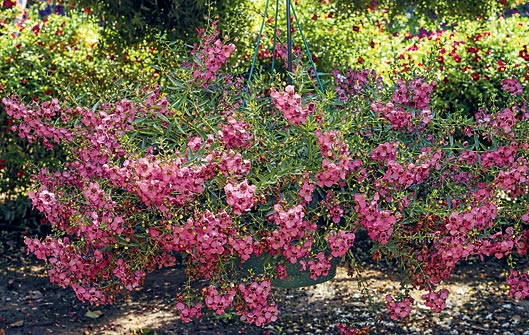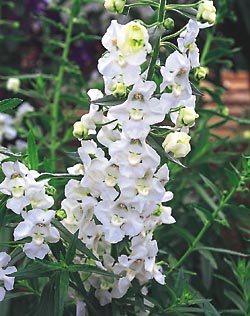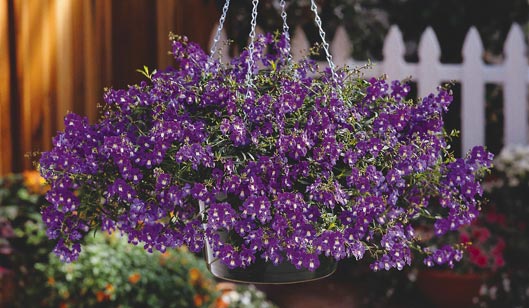 The Flower Fields
The Flower Fields
‘Carita Deep Pink’
by George Papadelis
Angelonia is one of the most versatile plants available to today’s savvy gardener. When planted in the sun it blooms effortlessly all summer long and can be used a number of different ways.
The common name for angelonia is summer snapdragon, but most gardeners are comfortable with the scientific name. The individual flowers actually look more like tiny orchids than snapdragons, but they develop on long stems just like snapdragons. Unlike snapdragons, however, angelonia performs beautifully in the summer heat. Removing the spent blooms will promote additional flowers but is not necessary. Simply plant in rich, well-drained soil with some sun (at least 6 hours) and fertilize every few weeks. Angelonia will do the rest.
Varieties are available in about 5 colors that include shades of white, pink, blue, purple, and a unique purple and white bicolor. Most varieties are upright growers that reach a height of 12 to 18 inches. These are by far the most popular and versatile cultivars. Their stiff stems are strong enough to prominently support the beautiful flowers in severe rain, but also pliable enough to sway in the wind without ever breaking. The three most common series are the Angelface, Carita, and AngelMist.
 Proven Winners
Proven Winners
‘Angelface White’There are also cultivars that were bred for a cascading habit. These can be used by themselves in hanging baskets or they may be incorporated into mixed planters as a trailing accent. The AngelMist series offers Basket Purple and Basket White. The Carita series offers Cascade Deep Pink, Cascade White, and Cascade Deep Purple. These perform just as effortlessly as the upright cultivars but are used in a different way.
As far as the uprights go, they are extremely versatile. I have seen mass plantings of angelonia that look just as gorgeous up close as they do from a hundred feet away. A sea of vibrant, orchid-like flowers clustered on upright stems can be stunning. Angelonia can also be used as an annual border plant. Use them just as you would medium height snapdragons, but with a more limited color range and superior performance.
They may also serve as an upright element in the center of a combination planter; it’s far more interesting than a spike. For example, a white angelonia can certainly be used with a red geranium. Better yet, try the white angelonia with a rose-colored geranium and a trailing blue fan flower (Scaevola). Maybe even add some trailing silver from a lotus vine or a lamium. The blue angelonia looks great with pinks, whites, and a splash of silver or dark foliage.
Now here’s an added bonus: For you perennial purists who are open-minded enough to have read this far, angelonia could be your best friend. Since it is underused and has a perennial-like appearance, it can serve as a graceful, perennial border filler with easy flowers from spring until fall. Other exceptional annuals for the sunny perennial border include tobacco flower (Nicotiana) , Amaranthus, the tall ageratum ‘Blue Horizon,’ tall verbena (Verbena bonariensis), spider flower (Cleome), and many more. As the lines between annuals, perennials, and tropicals continue to blur in American gardens, angelonia will become more and more popular.
George Papadelis is the owner of Telly’s Greenhouse in Troy, MI.

Simply Beautiful
‘AngelMist Basket Purple’
•••••••••••••••••••••••••••••••••••••••••••••••••••••••••••••••••••••••••••••••••••••••••••••••••••••••••
Angelonia pricing
Angelonia plants available prior to 2006 were grown from cuttings. Plants propagated from cuttings are more expensive to grow and are usually offered in pots (as opposed to flats) that are sold at a higher price, which makes them economically impractical for mass plantings. In contrast, seed-grown annuals are usually offered in flats (as opposed to pots) that are sold at a much lower price per plant. As such, seed-grown annuals are more economical for larger plantings.
The good news is that a seed company started offering angelonia from seed during the 2006 season. The series is called Serena and it comes in four colors (lavender, lavender pink, purple and white) and a mixture. They are only 12 inches tall and grow about 12 inches wide. This means that you will be able to buy a flat of beautiful angelonias and use them for a reasonably-priced mass planting. As you can see, plant breeders have recognized the value and potential popularity of angelonia. They continue to dedicate themselves to broadening the uses and color range, so keep an eye out for exciting future introductions.
•••••••••••••••••••••••••••••••••••••••••••••••••••••••••••••••••••••••••••••••••••••••••••••••••••••••••
At a glance: Angelonia
Common name: Summer snapdragon
Botanical name: Angelonia (an-jeh-LOW-nee-uh)
Plant type: Annual
Plant size: 12-18 inches tall
Habit: Upright; some varieties are cascading
Flower color: White, pink, blue, purple, purple & white bicolor
Flower size: 3/4 inch wide
Bloom period: Summer
Light: Sun
Soil: Fertile, well-drained
Uses: Annual, filling in gaps in the perennial border, containers (both upright & cascading varieties)
Remarks: Does well in the heat of summer
